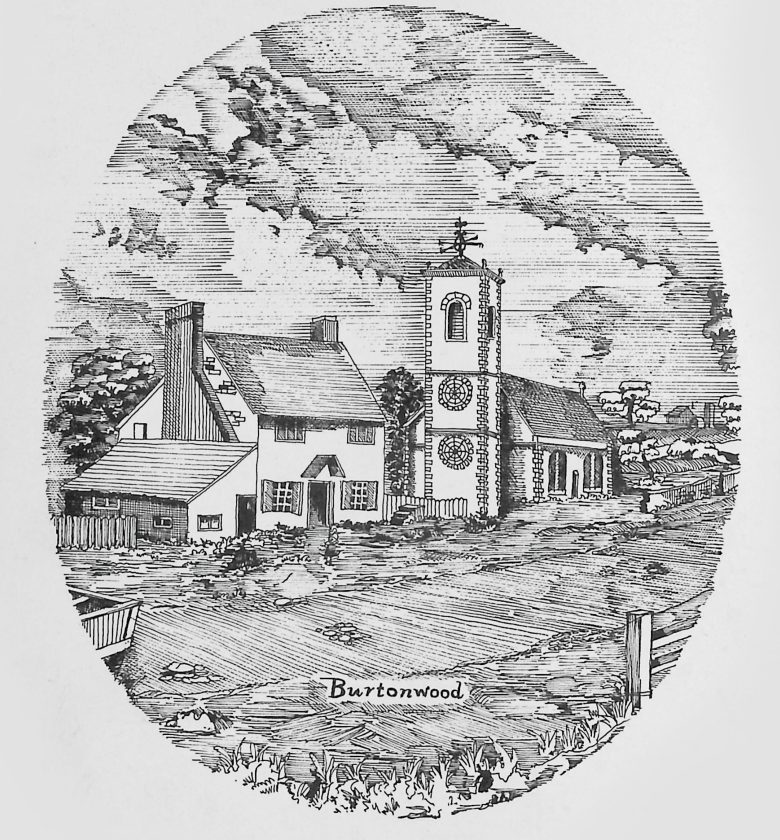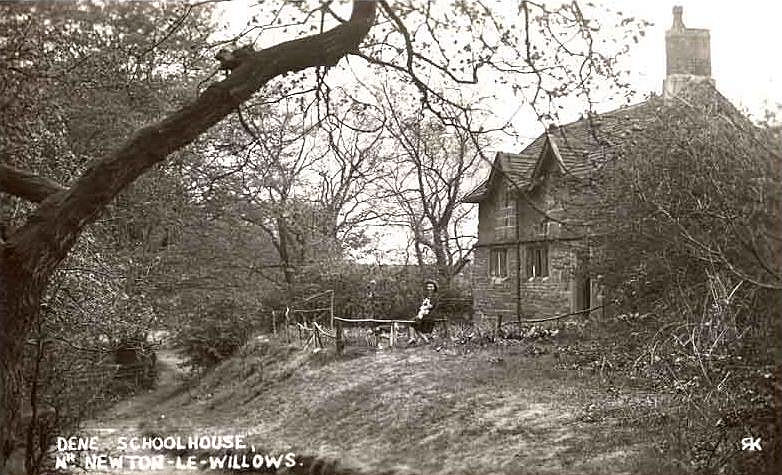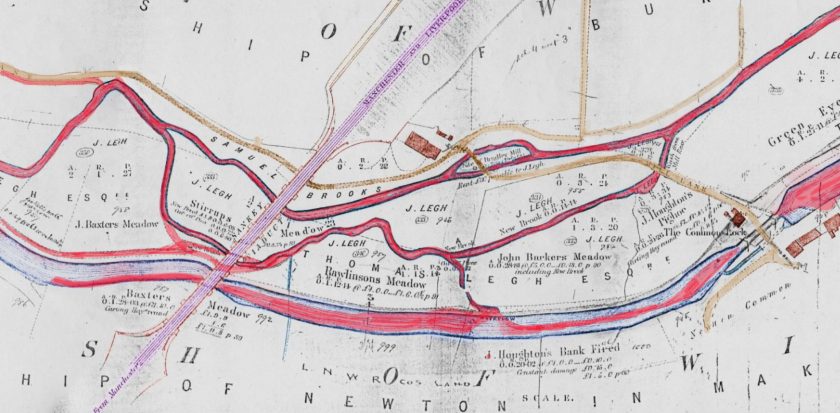Details relating to its early history and later domestic use were discovered during the course of this research. Information about its builder and later residents will also be considered, along with some details about the Dean School Trust set up by the original builder of the property.
THE FOUNDATION OF THE SCHOOL
Dean School, or Dene School, was founded in 1677 by John Stirrup.(1) The building was erected on a piece of barren land.(2) The date of construction is cited on an inscription that was over the front entrance to the school;
JOHN : STIRRVP : BVILT : THIS : SCOOLE
HOVSE : VPON : HIS : OWN : COST : AND : CHA
RGES : AND : GAVE : THE : VSE : OF : FIFTY : POV
ND : FOR : EVER : IVNE : THE : 6 : 1677 :- (3)
(John Stirrup built this school-house upon his own cost and charges and gave the
use of fifty pound for ever June 6 1677)
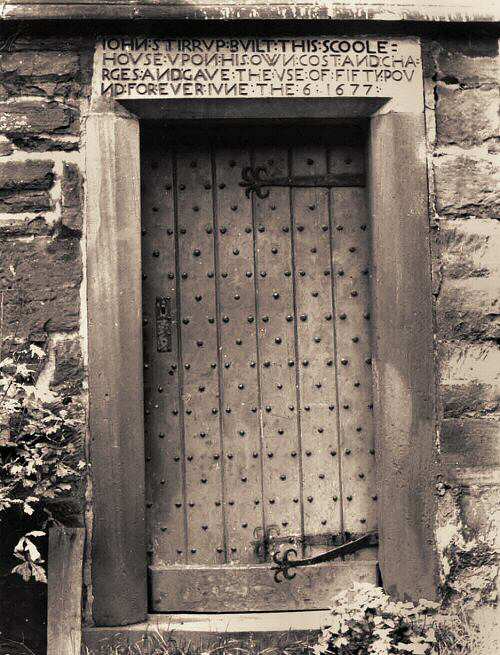
However, It appears that John Stirrup died before the building of the school was completed It was certainly not finished when he made his will on 8th May 1677.
"And further my will and mind is and I doe order and appoint that the said schoole shall be perfected and finished concerning the
(1) St. Helen s Library, Local Studies Unit, ref M/W/8 Wiswell Papers; Chronological notes on the History of Newton, (Henceforth, Wiswell, Chronological Notes) Baines, Edward, History of Lancashire, (Henceforth Baines, Lancashire), Cole, History of Newton-in-Makerfield, p. 81 (Henceforth Cole, Newton), Pevsner, Nikolaus, Lancashire: The Industrial and Commercial South, 1969, p. 355. (Henceforth Pevsner,Lancs; South), Lane, History of Newton-in-Makerfield, Vol II, pp.23/4., (Henceforth Lane, History) St. Helens Library, Local Studied Unit, Will of John Stirrup, 8/5/1677, (Henceforth, Stirrup, Will)
(2) Wiswell, Chronological notes.
(3)Cole, Newton, p. 81 and Lane; History, p.23.
building thereof with the moneys taken out of my personal/ Estate. (4)
Stirrup clearly had the financial means to build such a property. His will contains various bequests of sums of money between £50.00 and £100.00. The inventory of his goods, taken shortly after his will was made, 24th May 1677, totals £445. 5 shillings and 2 pence, a considerable amount of money at that time. (5)
As the inscription says, Stirrup bequeathed £50 to the school. This is confirmed in his will;
"Itm, I give and bequeath the sum of fifty pounds for and towards the maintenance of a schoolmaster at my school in Newton the interest whereof I do order and appoint to be paid yearly unto the master there and the stock to remain for ever." (6)
Lane cites Bishop Gastell from his Notitia Cestriensis, who claims that the school was built by Stirrup 31 years earlier in 1646. Lane is correct in pointing out the discrepancy and saying that the date of 1677 was probably the correct one. (7) However, as Stirrups will shows, the date of 1677 is certainly the correct.
(4) Stirrup, Will.
(5) Stirrup, Will and Inventory.
(6) Stirrup, Will.
(7) Lane, History, p.24.
It is not certain who was the first master of the School, but John Stirrup made provision in his will for one Thomas Stirrup, presumably a relation, to become the master at some point, providing he proved to be suitable for the position.
"And my Will and mind is that this said Thomas Strirrup [a scholar living with John Stirrup] shalbe Master at my schoole if it shall please God to spare him life and that he shalbe found capable of it So the which purpose I desire my executor hereafter named to allow him the advice and assistance soe far as it is reasonable and modest." (8)
No evidence has been found to indicate if Thomas Stirrup did in fact take up the position of Schoolmaster, but this lack of evidence to does necessarily mean that he didn t. No evidence has been found, either, to prove to the contrary.
(8) Stirrup, Will.
SCHOOLING DISCONTINUED AT DEAN SCHOOL,
Dean School ceased functioning as a school at the end of the 17th century, at least the original property did, although the name carried on. What appears to have happened is that the actual schooling of the pupils took place in another building, but the name, Dean School continued to be associated with the new building as did the endowment of f50 bequeathed by John Stirrup. Evidence of this comes from documents relating to the establishment of the Dean School Exhibition Charity during the last quarter of the 19th century. These documents show that the Master of Dean School, Mr. George Armitage, died in 1875, and the Trustees had difficulty replacing him. (9) Details of this will be considered later, but Mr. Armitage was clearly teaching at Dean School right up to his death in 1875. Therefore the actual teaching must have taken place in a totally different establishment to that which had been built by Stirrup in 1677. This property was now residential and had been for a number of years as successive census returns had shown.
Lane is a little ambiguous about what happened following Dean Schools time as a school. He believes that Dean School ceased to function in that capacity when Peter Legh built a Free School near the Church and that the scholars from the original school moved to the new one.(10)
He goes on to say that " this arrangement would continue down to the demolition of the old school about 1840
(9) St. Helens Library, Local Studies Unit, Ref, S/E/55/3, Dean School; Minute Book. (henceforth Minute Book)
… ". He does not make it clear which school was demolished, the one built by Peter Legh, or Dean School. However, he must have been referring to the one built by Peter Legh as the original Dean School (1677) was never demolished, although re-built during the 1970s. Even when it fell into disrepair before its rebuilding, it displayed features of its 17th century origins.
It would seem that the name Dean School continued to be used although the original building was not used for this purpose. The name appears to have been used successively for the Free School of Peter Legh s and the school that was kept in the Old Cockpit after the latter was demolished. Mr. George Armitage taught here for a short while and then in 1865 he taught at a school he had built himself also in Rob Lane. (11)
It was following his death in 1875 that the Trustees, after years of negotiation and debate, finally set up the Dean School Exhibition Charity, funded by the endowment of the original Dean School by Stirrup. Therefore, the school in Rob Lane that Mr. Armitage built and where he taught, must have carried on the name of Dean School. This is confirmed by an entry in kellys Directory of Lancashire, 1873. In the section confined to Newton-in-Makerfield, under the listing for schools, is an entry for `Deans Endowed, Geo. Armitage, Master (12)
This also shows that the school was still being funded by the trust set up from John Stirrups original endowment of £50 in 1677.
(10) Lane, History, p.24.
(11) Ibid p.24.
(12) Kellys Directory of Lancashire, 1873.
It is clear from the Census Returns that Dean School and George Armitages Dean s Endowed School were two separate buildings. The Returns for the period (that will be considered later) show people other than George Armitage living at Dean School House and the relevant Census entries indicate that it was being used for domestic purposes and not a school.
Cole cites and indenture dated 1752 which appears to confirm much of the above.
The indenture states:
"by Indentures of Lease and Release, bearing date 20th and 21 St November, 1699, conveyed to Peter Legh and others a massuage called Dean School, and a close of ground thereto belonging, in Newton, without declaring any trusts of the same, but that it was intended that the same should be held in trust for the schoolmaster of Dean School; and that upon the death of the said Peter Legh, party thereto and further reciting, that the said John Stirrup gave the master of Dean School an annuity of £3, issuing out of the messuage in Newton called Crow-lane House, which premises were then the inheritance of the said Peter Legh, party thereto; the said Peter Legh granted and confirmed the said annuity of £3 issuing out of the said messuage, to the said Thomas Britherton, and others, parties of the second and third parts, their heirs and assigns; and also conveyed and also conveyed to them the said messuage or tenement called Dean School, and the ground thereto belonging thereinafter mentioned; and the said Peter Legh, and the parties of the secong part, also conveyed to the said Bennet Legh and others parties of the third part, their heirs and assigns, a close containing by estimation four acres of land, lately inclosed from that part of Newton Common called Leylands Common, upon trust, that all the said parties thereto, expect Mrs. Markland and Margaret Stirrup, should be trustees for all the said premises for the use of the schoolmaster of Dean School for the time being, and should receive the rents of the said premises, should yearly teach and instruct in English any number of poor neccesitous children of the said township, not exceeding ten: " (13)
The parties named in this indenture where;
In the first part — Peter Legh.
In the second part — Thomas Brotherton and several others, described as Charterers and freeholders of the borough and Township of Newton.
In the third part — Bennet Legh, William Banks, the younger, John Blackburne, Thomas Plumbe, John Legh. (14)
(13) Cole, Newton, pp. 69/70.
(14) lbid p.69.
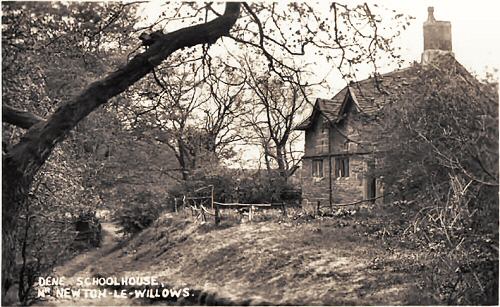
Although this document does not directly state that Dean School House had ceased to, or was ceasing to, be used as a school, the content does indicate this to be the case. The fact that the document states that the master of the School should receive the rents of the said premises, indicates that it was not being used as the School house, but was being let and rent was being charged for it its use. (15)
Just over 50 years later, it would appear that the Reverend William Brotherton, possibly the son of Thomas Brotherton, was living at Dean School. A transcript of a List of the Newton Freeholders, held at the John Rylands Library Manchester, 1750, curiously shows Brotherton as both the Freeholder and tenant of Dean School. However, the entry listed under tenants does not give the sum of rent. (16)
Whether or not the building ceased being used as a schoolhouse in 1699, it had certainly stopped being used in this capacity by the last quarter of the 18th century. Referring to a report dated 1828, Cole states that `the then master [of Dean School] was appointed by Thomas Legh, Esquire, in 1818; he kept school in the Court-house, which had been used for the purpose for upwards of 50 years. (17)
Therefore, the schooling of the pupils had taken place in the Court-house since about the 1770s, although the name Dean School was still being used.
(15) lbid p. 69.
(16) St. Helens Library, Local Studies Unit, Ref,• SY/2/2, Legh Estate Papers — Transcription of List Of Newton Freeholders, 1750, held at the John Rylands Library, Manchester.
(17) Cole, Newton, p. 70
The Land Tax records dating from the late 18th and early 19th centuries do not provide any concrete information regarding Dean School. The records of 1781 for Newton show a Mr. Brotherton as the proprietor of a number of properties, nine in total, that are all let to other people. However, none of these names can be identified with Dean School and the document does not give the names of any of the properties involved, merely the name of the owner and tenant. (18)
The assessment for 1803 does not mention Dean School, but mentions a School House, occupied by James Marsh and owned by Rev William Boardman.(19)
There are no other details given, therefore it is not possible to say if this entry refers to Dean School or not.
By 1828 Dean School House (1677) had been converted into cottages. In 1828, all the trustees appointed in 1752 were all dead, so it was deemed necessary for a conveyance to be obtained from the heir of the last surviving Trustee to appoint new trustees. A report relating to these proceedings dated 12th June 1828, illustrates that the property was now a cottage. Listing the property belonging to the school includes; (20)
(18) Lancashire County Record Office, Land Tax Records Ref QDL/1781/WD/57.
(19) Lancashire County Record Office, Land Tax Records, ref QDL/1804/WD/57.
(20) The term school is a ambiguous in this context. It appears to be a collective term for all the properties and lands held in trust to finance the schooling of the pupils, supporting the master and to cover the general running costs. It does not refer to a particular property.
`The old school given by John Stirrup, then converted into a cottage, with the garden and close, containing together la. 3r. 16p. statute measure, let by the schoolmaster at £8 per year. (21)
(21) Cole, Newton, p.71.
It would appear therefore, that the property known as Dean School, built by John Stirrup in 1677, ceased to function as a school some time between 1699 and the 1770s. The name, Dean School, however, continued to be used although the schooling actually took place elsewhere. The annuity of £50, left by John Stirrup, together with rents derived from other pieces of land and property was still used to finance the teaching of pupils and supporting the master. John Stirrups original building of 1677 was at some time converted into cottages, certainly by 1828.
DEAN SCHOOL COTTAGES
It is not clear who lived at Dean School after its conversion into cottages until the 1830s, apart from the possibility that William Brotherton resided there circa 1750. John and Annie Hindley were living there around 1837. Citing source from 1837 Cole quotes;
At the Old School House (Stirrups) in Rob Lane, we should find John and Annie Hindley, where this worthy couple bred the game Cocks for Mr. Legh. This John Hindley was organ blower at the church for about 50 years.(22)
The Hindleys lived at Dean School House until the 1870s. The 1841 census returns give the address as the Old School House, Rob Lane. John Hindley, whose name is incorrectly given as James, is described as a 50 year old labourer having been born in Lancashire. His wife, Ann s, age is given as 45, and she was also born in Lancashire. With them lived their 20 year old son, James, also born in Lancashire, and one servant or lodger. He was James Marsh an 80 year old labourer who had been born in Lancashire. (23)
(22) Cole, Newton, p.296.
(23) 1841 census returns, ref, H0107/524/14 ff.24.
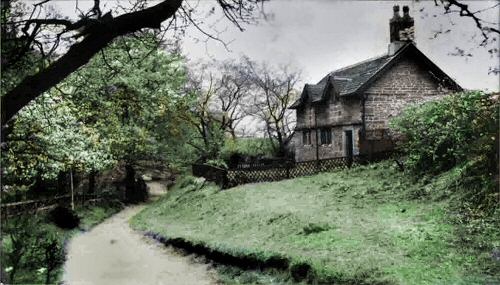
Ten years later the census returns give more exact ages and places of birth. John Hindleys age is now given as 59 and shown as having been born in Bedford, Lancashire. His occupation is now given as an Agricultural Labourer. Ann s age is 57 and her place of birth is given as Golborne. Their son seems to have aged rather a lot in 10 years. His age is now given as 35 and he is recorded as having been born in Newton. He is described as a cripple from childhood unable to work. Their residence is described as Dean House .(24)
In 1861, nothing has changed apart from their ages being ten years older. The property is now described as Dean School House.(25)
Ten years later, John Hindley is still living at Dean School House. He is now 79 years old and a widower, Ann having died some time during the last 10 years. There is no mention of James, John s son, either. (26)
(24) 1851 Census returns, ref; HO107/2202 f 128.
(25) 1861 Census returns ref.; RG9/2788/8
(26_ 1871 Census returns, ref, RG10/3899 f 141.
Initial searches of the 1881 Census Returns for Newton-in-MakerfIeld failed to show who was living at Dean School House at that date. The entries in the Returns for Rob Lane do not give the names of individual houses, they are all just referred to as Rob Lane. There was no mention of John Hindley living in a property in Rob Lane, therefore it was concluded that the Dean School must have had new occupants. However, finding the relevant entry on the 1891 Census Returns led to identifying the property on the 1881 Returns.
In 1891 Thomas Clark and his family were living at Dean School House. (27)
Having found this information as search was made for this family on the 1881 Census Returns and the family was found to be living in a property in Rob Lane. This presumably was Dean School House. (28)
Thomas Clarke was 45 years old and a Labourer in the Paper Works. He had been born in Scotland, as had his wife, Barbara, who was 46 years old. (29)
They had 6 children. The eldest was John, 21 years old, and a Labourer at the Iron Foundry. Next came Roderick. He was 19 years old and also worked as a Labourer at the Paper Works like his father. Peter and Kate were both 15 years old and Peter also worked at the Paper Works. Polly was 12 and a Scholar, as was 9 year old Thomas. All the Children were born in Newton. (30)
(27) 1891 Census Returns, RG12/3070 if 44/5.
(28) 1881 Census Index, CD-Rom version, ref; RG11/3787 ff 46
(29) Ibid
(30) Ibid
As already established, the Clarkes were still at Dean School House 10 years later in 1891. There is a slight discrepancy over ages though. Thomas s age is given as 9 years older, at 54, and Barbara has only aged 7 years! Her age is now given as 53. (31)
John is no longer shown as living with the rest of the family. Roderick, now 29, is working at the Iron Foundry, whilst Peter, 25, is still at the Paper Mill. Kate, also 25, is working as a Paper Sorter at the Paper Mill. Polly now appears to be called Mary. She is 22 years old, and also a Paper Sorter. Thomas is a Gardener. (32)
(31) 1891 Census Returns, RG12/3070 ff. 44/5.
(32) Ibid
DEAN SCHOOL HOUSE IN THE TWENTIETH CENTURY
Despite searching the Electoral Rolls for the early part of the 20th century the names of the residents of Dean School House could not be found. The early Electoral Rolls are listed alphabetically by name, not property, but even so, no one could be found as being described as either owning or living at Dean School. This was not entirely surprising as the names of individual properties were not often mentioned A brief description of the property was given instead, which in many cases, could equally describe a number of different properties.
However, Dean School was mentioned in some mid 20th century Electoral Rolls. In 1945 Joseph Thorpe and Edith Hill were shown as living at Dean School House. (33)
Four years later in 1949, Albert and Margaret Gregson are recorded as living there. (34)
(33) Lancashire Record Office, Electoral Rolls, 1945 ref; EL/6/2/13.
(34) Lancashire County Record Office, Electoral Rolls, 1949, ref, EL/7/2/13
Dean School House was first listed on 3rd February 1966. (35)
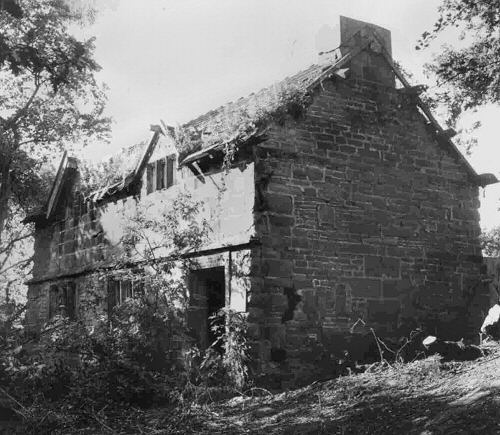
Nikolaus Pevsner, in Lancashire: the Industrial and Commercial South, published in 1969, describes Dean School House as `a very Humble two bay cottage with dormers; symetrical. (36)
(35) St. Helens Metropolitan Borough Council, List of Buildings of Special Architectural or historical Interest and Schedule of Ancient Monuments, June 1994.
(36) Pevsner, Nikolaus, Lancashire: the Industrial and Commercial South, Penguin, 1969. P.355.
By this time the property appears to have become derelict, although Pevsner does not mention anything about this. According to Mrs. Pat Collier of Newton Historical Society, it was rebuilt and an extension added during the early 1970s by a Mr. William Hopkins. Much of the original stonework was re-used in the rebuilding according the local Conservation Officer. New stone was added only where really needed and then to match colour and style of the original stonework, this can be seen in the stone mullioned windows that are identical to the original 17th century ones they replaced. Mr Hopkins later sold the property to a Mr. Les Nichols. He added a double garage. It is not known who the current owners are. When the recent photographs were taken, the owners were found to be away from home, although an attempt was made to speak to them at the time.
CONCLUSION
Although clearly rebuilt and modernised in recent years, Dean School House does still retain some of its original 17th century features saved and recycled for use in the present structure. The stone work and at least one stone mullioned window frame, were used to rebuild the property, and as such, means that the building still has some of its 17th century character even though it is basically a new property. The stone mullioned window, containing 5 pains of glass, on the wing to the right hand side of the front door is clearly of 17th century style and is probably from the original property. Photographs of the building when it was derelict prior to its re-building, clearly show a similar mullioned window frame on one of the gable ends. As all the other window frames are of a more modern design, although similar in style and material, it is almost certain that this window frame is from the original property. Otherwise, if the window frames were all new ones, then it would seem more logical to have them all made to match.
On first glance at this wing of the rebuilt property, it appears that it is identical to the original building, as seen in the pre-rebuilding photographs. The dimensions, positioning of the stone mullioned window and the beading around the middle of the building all seem to be the same in the current property and the original, this suggesting that the original was repaired and an extension added However, on closer inspection it does become obvious that this wing has been totally rebuilt.
When a comparison is made between the positioning of the individual stones on the new building and the original, it is clear that the new wing has been totally rebuilt as the stones are all in very different positions to where they were on the original. The re-building of this wing has certainly been done .sympathetically and as accurately as possible to the original.
On this new wing, above the 17th century stone mullioned window is John Stirrup s original date stone of 1677.
John Stirrup s original building of 1677 was only used as a School House for a relatively short period, being converted into cottages sometime between the end of the 17th century and middle of the 18th century. The name of the school, along with the £50. Endowment from Stirrup lived on into the late 19th century when schooling took place in other premises. Later, when the trust, who administered the Endowment, could not find another suitable schoolmaster to continue education, the funds, from the Endowment were used to help finance local children to embark on further education.
Many of the sources relating to Dean School, on examination, related to this trust. However, many documents were found that gave details about the original property, but an number that were examined failed to yield any relevant information. These included the Land Tax Records and some surveys of the township. Particularly where only the names of owners and tenants of properties were given it was difficult to identify Dean School House. Nevertheless, much information about the property was found and these details fit together to build up a picture of the history of Dean School House.
Now entering its 5th century, John Stirrups School still lives on in both name and fabric, although rebuilt. The original date stone stands as a reminder of its early origins.
Special thanks for the use of the text in this posting must go to one of the website visitors “Marjorie”, who describes herself to me as a “Lancastrian in London”.
Marjorie informs me that she was brought up In Newton close to Newton Hall, and that some years ago she commissioned a history on both Newton Hall and Dean School, Marjorie posted to me some months back the photo copied pages concerning Dean School, which I have now transcribed here for you.
please take note that since I am typing all this, and I can niether spell or type well, some errors and ommisions in the history, are to be expected.
Flushed with the success at finishing the Dean School text, I will now attempt the larger “History of Newton Hall” which Marjorie has also so kindly posted to me.
Watch this space …..

